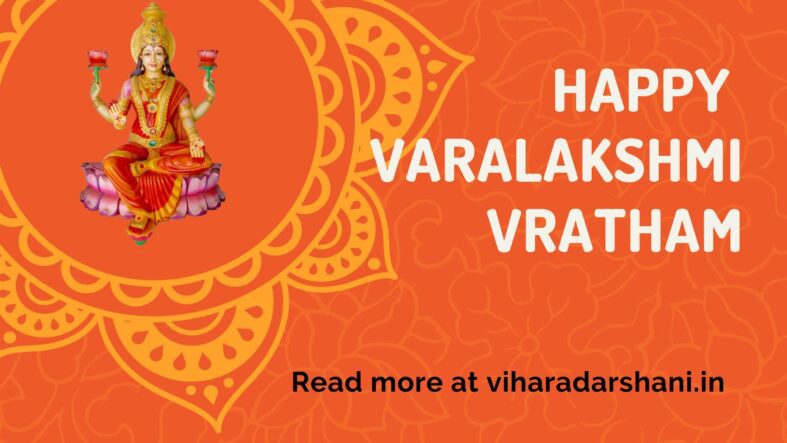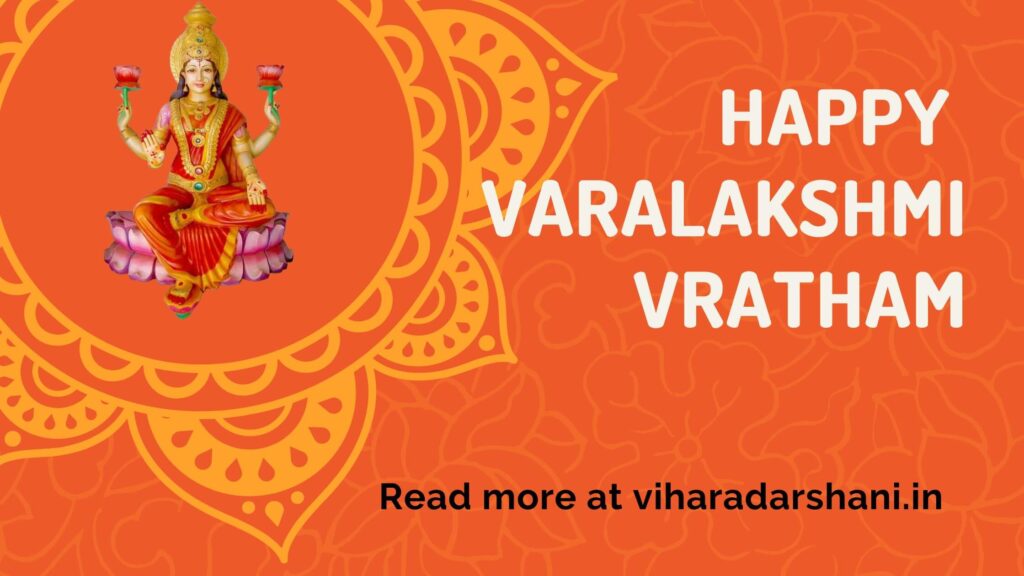Varalakshmi Vratam
Varalakshmi Vratam/ VaraMahalakshmi Vrata is a festival held in honour of the Goddess Lakshmi. Varalakshmi is a goddess who bestows boons (“Vara”). Many women in Karnataka, Andhra Pradesh, Telangana, Tamil Nadu, and northern Sri Lanka perform this important pooja. The Hindu festival known as ‘VaraMahaLakshmi Vrata‘ is held on the second Friday, or the Friday before the full moon – Poornima – in the month of Shravana, which corresponds to the Gregorian months of July and August.
Women perform Varamahalakshmi Vrata for their own health and the health of their entire family. Worshipping Varalakshmi on this day is thought to be equivalent to worshipping Ashtalakshmi – the eight goddesses of Wealth, Earth, Wisdom, Love, Fame, Peace, Contentment, and Strength. Because of the growing popularity of this holy day in some states, India has declared it an optional official holiday.
Varalakshmi vratham was narrated by Lord Shiva himself, making it one of the most powerful observances. Those who follow this vratham will be relieved of their sorrows, pains, and financial difficulties. At home, tranquility and harmony will reign supreme.
Varalakshmi Vratam History:
A woman named Charumathi lived in Kaundinyapur, a town in the Magadha Kingdom of old. The Goddess Mahalakshmi appeared in her dream, impressed by her devotion to the goddess, and asked her to worship Varalakshmi (Vara = boon, Lakshmi = goddess of wealth) and seek to fulfil her wishes. Varalakshmi is a variant of Lakshmi, the goddess of wealth. The prayer/worship was to be offered on the Friday of Shravan month, preceding the full moon night.
When Charumathi told her family about her dream, they encouraged her to perform the pooja. Many other village women joined her in performing the traditional pooja and offering many sweets to the Goddess Varalakshmi, along with sacred chants.
In the South, the goddess Meenakshi, a famous form of Parvati, performed this vratha in order to obtain Shiva as a husband.
Ceremony:
On this occasion, women worship Goddess Lakshmi with great devotion, offering fruits, sweets, and flowers. A varalakshmi vratham kalasam preparation (representing the deity) is usually decorated with a saree, flowers, and gold jewelry, and offerings are placed in front.
After the pooja is completed, a rakshasi/saradu (sacred thread) is among the offerings and is adorned on the wrists of women. This is worn to represent protection and piety, and several articles are given in good faith as gifts and charity. This pooja can be performed regardless of caste or creed. Many women still celebrate this traditional festival, praying to Varamahalakshmi for her blessings in the form of wealth and well-being for their families.
Significance:
Siri (wealth), Bhu (Earth), Sarasvathi (wisdom), Preethi (love), Keerthi (fame), Shanthi (peace), Santhushti (contentment), and Pushti are the eight recognised forces or energies (Strength). Each of these forces is known as a ‘Lakshmi,’ aka:
Lakshmi Aadi (the Protector)
Lakshmi Dhana (Goddess of Wealth)
Lakshmi Dhairya (Goddess of Courage)
Lakshmi Sowbhagya (Goddess of Prosperity)
Lakshmi Vijaya (Goddess of Victory)
Lakshmi Dhanya (Goddess of Nourishment)
Santaana Lakshmi (Progeny Goddess) Vidhya Lakshmi (Goddess of Wisdom)
The Hindus refer to all eight forces as the Ashta Lakshmis, or the eight Lakshmis.
Vishnu is also known as ‘Ashtalakshmi Pathi,’ which means he is the consort of the eight Lakshmis, or forces. In fact, because abstract force is beyond the comprehension of ordinary people, Vishnu, representing the preservative aspect of the universe, radiates these feminine energies of Lakshmi personified and worshipped as such. Because health, wealth, and prosperity are dependent on the rhythmic interaction of these forces, worshipping Lakshmi is said to bring these three. This festival is mostly observed by women in order to invoke the blessings of the goddess Lakshmi.
Legend:
According to legend, this is a pooja performed by the goddess Parvathi to seek prosperity and happiness. As a result, it became a model for women seeking boons (varam) for their family’s health, wealth, and knowledge. The pooja is performed on the Friday of the month of Sravan, in the fortnight preceding the full moon day known as Sukla paksha.
Varalakshmi Vratam Pooja Procedure:
On the day of Varalakshmi Vratam, one should wake up early in the morning and take an abhyanga bath. A mandapa should be set up in the north-east side of the house by covering it with cow dung. The mandapam should be decorated with fresh rice and beautified. Put the narikela on the kalash and decorate it with a red brocade cloth.First make the coconut smooth and make Amma’s face on the wider part. Make a paste of turmeric and apply it to the coconut. Then take some powdered turmeric and sprinkle it.
After that, take Maida flour and add some turmeric to it and mix it. Make the ears and nose of Amma by kneading this paste with your finger. Place the ears first and then the nose on the yellow painted part of the coconut. After that, the eyes should be marked on both sides of the nose with thin clamps. Eyebrows should also be drawn and the eye sockets should be painted with rice flour. Then the bite should be covered. Keep it aside and take a large piece of stone for the urn and tie a stick in the middle of it. Take another wooden stick and tie another small stick to the left side and wrap the blouse cloth around it. Place a small mara chembu on the big one and decorate the third part of the saree with a bunch.
Then the hands should be placed on Amma. Make sure that the abhaya hand is slightly back and the middle hand is slightly forward. A baby pillow-like shape should be placed on the urn so that the mother can stand on it. The jewellery should be decorated before the face of the goddess is placed on the kalash. A small bowl should be placed on them like the mother’s neck. As it is like a kantha, a kanthabhaaran should be kept. Then ear-rings and nose-piece should be placed and the face should be placed on the urn. Then the light weight crown should be placed on the head.
Then one should invoke Goddess Varalakshmi. Worshipping Varalakshmi should be chanted with Shodashopachara and Ashnottarasatha names. Among the eight hundred names of Ammavarini, each name has a peculiarity. There are 108 stories related to this in the Vedas. In Brahma Vaivarta, Vishnu, Skanda, Padma and Khanda Puranas, Lakshmi Vaibhogam and Pujaprasathya are mentioned.
Varalakshmi Vratam Pooja Items:
- Turmeric
- Saffron,
- Sandalwood
- Flowers
- Garlands
- Betel leaves
- 30 Bananas
- Dates,
- Agarbattis
- Camphor
- petty cash
- white cloth
- blouse cloth
- Mango leaves
- Five kinds of fruits,
- Varalakshmi photo
- Coconuts
- White thread or nomu thread,
- Rice and Panchamrita
- Deepapu kundulu
- Othulu
- Ghee
varalakshmi vratam date 2022 : varalakshmi vratam date is Friday, August 12th
varalakshmi vratam Images:


